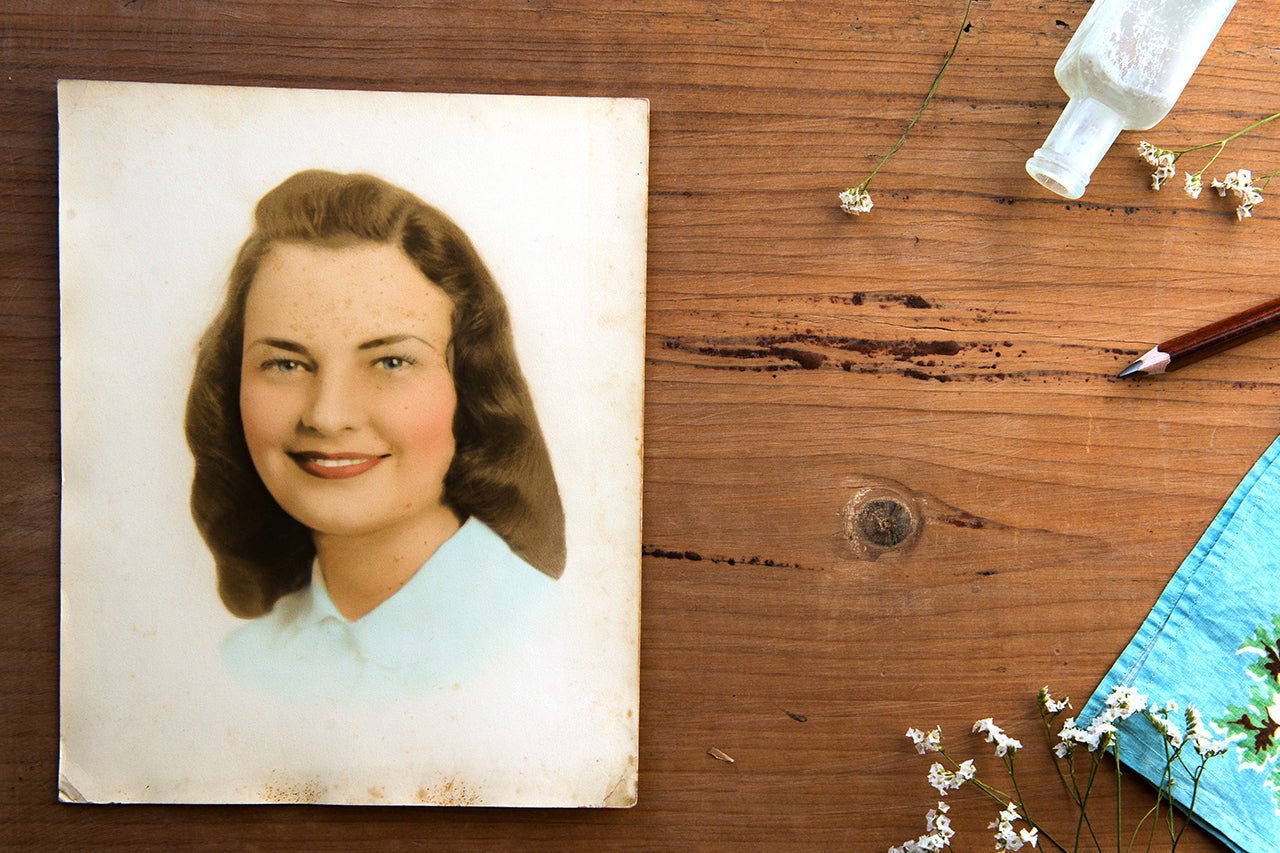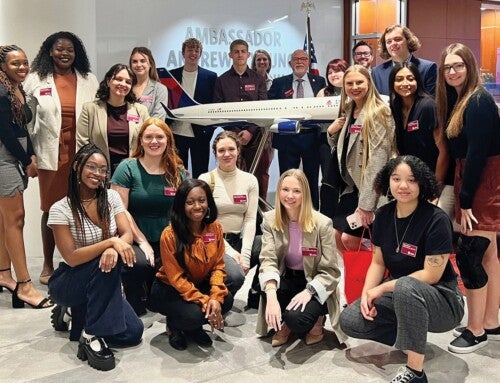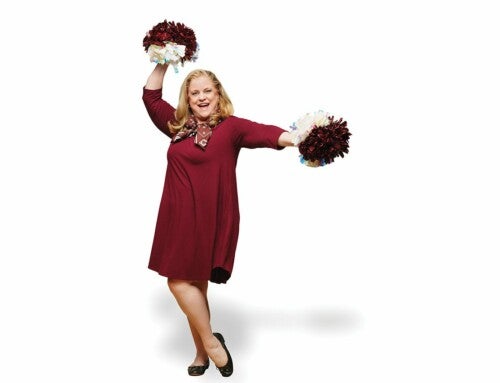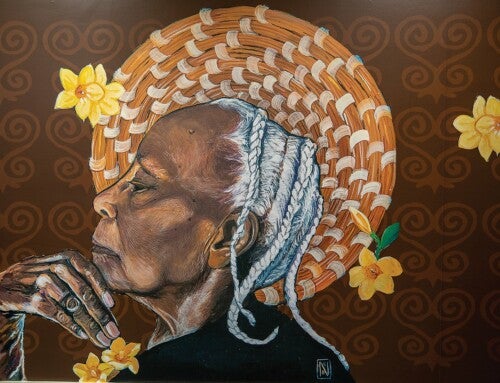In the spring of 1942, a College of Charleston student by the name of Mary Croghan was called, along with a few of her female classmates, to the president’s office in Randolph Hall. There they learned they had been selected to serve in a top-secret capacity amid the United States’ growing involvement in World War II. Telling anyone of their duties, the young women were told, would carry a heavy penalty.
It was highly sensitive military intelligence concerning a nation at war. The fate of American servicemen lay squarely in her hands. The encrypted data at her fingertips contained deadly serious wartime business. Or at least, that’s what she said.
For decades after her days as a College of Charleston student, Mary Croghan Ramsay ’42 regaled friends and family with recollections of afternoons transcribing code at the Charleston Navy Yard during its peak activity in World War II. But how exactly did a book-loving sorority sister from Church Street wind up in the thick of mission-critical cryptology during the height of a global conflict?
Her story – according to bemused and bewildered family members – was this: While enrolled at the College, the young student and a few other female classmates were summoned to the president’s office in Main Building (today’s Randolph Hall). There, George Grice (for whom Grice Marine Laboratory is named) relayed the news that each of them had been selected for a special role in the war effort. The nature of their work, which involved the transcription of codes, was nothing short of life and death.
Family lore frequently involves its own inscrutable code. Age-old anecdotes often gain a life of their own, burnished and reshaped by that faulty cognitive device known as human memory. Facts and figures lose their bearing, wobbling and blurring through decades of retelling like a time-traveling game of telephone. When stories earn a luster that leans towards the fabulous, those around the dinner table may nod, chuckle and carry on with the busy, distracting work of being a family.
However, when the teller of the tale has a formidable track record of talking the talk, walking the walk, and never ceasing to surprise, the tale bears further investigation. Since the nature of Ramsay’s work was classified, piecing together her service on behalf of the United States during World War II presents a particularly daunting paper chase. It is a code best cracked by cobbling together bits of research, facts and stories, with the hopes of coming up with compelling corroborating evidence to support it.
Since her death in 2009, Ramsay’s version of events is now entrusted to those who heard her stories. Her daughters, Mariana Ramsay Hay ’82 and Rhett Ramsay Outten, each have ample snippets to recreate a narrative. There are also dog-eared official documents, yellowed with time and tucked in various file drawers, which have now been ferreted out. There are evocative black-and-white photos, the settings of which are easily traced to the Charleston Naval Base of the 1940s. And, there is our own emerging knowledge of recent research on women’s involvement in cryptography during World War II.
These scattered memories and tattered scraps of paper together create a collage representing a pivotal moment in our nation’s history. It was a moment that swept up many College of Charleston students, who adjusted their studies and career tracks to serve the country. It was a moment that made its presence known on our campus, with buildings relegated to the war effort. And, for the first official time in our country’s military history, it was a moment that called for the considerable wits and airtight honor of more than a few good women.
One of those women was undeniably – and instrumentally – Mary Ramsay.
THERE’S SOMETHING ABOUT MARY
Those familiar with the name Mary Ramsay (and they are legion) may think more about gems than about German U-boats. Shortly after graduating from the College, she joined her father, William Croghan, at Croghan’s Jewel Box, the fine jewelry and gifts store he founded in 1907 on Charleston’s King Street. A longtime go-to for the sparkling stuff of life – from silver rattles to bejeweled betrothals – its staff these days includes an ever-expanding corps of descendants from her marriage to George Ramsay.
Ramsay is also remembered as a galvanizing force throughout the city – as well as the state of South Carolina. In the 1970s, in a Charleston far more subdued and a tad worse for wear, she joined forces with Mayor Joe Riley and former College of Charleston president Ted Stern to ensure the success of a burgeoning international arts festival called Spoleto Festival USA, rallying even the most retiring Charlestonians around the cause. She applied that same indomitable spirit to her advocacy for the mentally handicapped, inspired by her own experience with having a son born with Down syndrome, to ensure more state resources for those with developmental disabilities.
“It’s not surprising,” says Riley, of Ramsay’s work during the war. “She was smart as a whip, very intuitive and clever, and would have been ideal for that position. She would keep her confidences and would be determined.”
Riley, who worked closely with Ramsay throughout the years, is also not surprised that he had never heard about her wartime role, noting that she rarely talked about herself. “The U.S. government was very lucky to find her to attend to this job,” he says.
And, throughout her life, the proud alumna remained a vibrant presence at her beloved alma mater, the place in which she had cultivated an enduring love of literature and communications, the focus of her studies as an English major. In 2008, she received an honorary Doctorate of Humane Letters for her contributions to the institution.
Today, the Ask Jackie Scholarship (which is a reference to her column in the student newspaper, The Meteor) supports incoming freshmen with an interest in the field of communication.
A TIME OF CRISIS
In 1941, the College was reeling from the news that its president, Harrison Randolph, had suffered a stroke in September, with his executive assistant, George Grice, serving as interim president and handling daily operations. In the 1941–42 edition of The Comet, the College’s yearbook, his president’s message begins by addressing this.
“Whatever the historian of the future writes of the college year 1941–42,” Grice writes, “he must make record that it was a year of crisis. Carrying on in the absence of President Randolph, readjusting to the grim fact that we are a nation at war, planning for a college year of twelve months, and endeavoring to cooperate with the military, naval, and civilian defense authorities are but a few of the emergency situations with which we are confronted.”
Without a doubt, the Charleston area felt the realities of being at war. For one, the Charleston Navy Yard had never been more active – or populated – than in the years following the Japanese bombing of Pearl Harbor on Dec. 7, 1941. A first-class defense activity, the military facility was charged with construction, repair and logistical support to operating forces, hosting thousands of soldiers, sailors and airmen en route to combat.
And enlisted individuals did not have to go far to experience the action. Naval maneuvers were taking place right in Charleston Harbor. On Jan. 22, 1942, The New York Times reported, “An oil tanker slipped quietly up to Fort Sumter here sometime yesterday and transferred to a Coast Guard twenty-one survivors and two victims from the torpedoed Latvian freighter Ciltvaira.” The article goes on to say, “The Navy restricted exact details on the locale of the sinking to ‘somewhere off the Atlantic Coast.’” In fact, it was sunk by a German U-boat near Nags Head, N.C., on January 19.
The action went the other way, too. On May 2, 1943, The New York Times reported: “A Coast Guard cutter sank a German U-boat off the Carolina coast several months ago, the Navy reported today, and captured thirty-three members of the crew, including the commanding officer. … The prisoners were taken to Charleston, S.C., and presumably now are being held in a United States prison camp, although the Navy did not comment on their present disposition.”
In A History of the College of Charleston, 1936–2008, author Nan Morrison writes that the interim president was fully on board with facilitating the military during the war. If that included Grice facilitating the recruitment of female students, Randolph, who was still officially president, would have come to the consideration informed. It was under his presidency, in 1918, that the College first admitted women.
Women on campus were already contributing, Morrison notes. “On the Cistern and in class, women knitted mufflers and socks for the soldiers,” she writes. “The Phi Mus carried cookies to the sick soldiers at Stark Hospital. The Delta Zetas wrapped bandages. Women from all the sororities were invited to dances sponsored by the USO in the auditorium of the College of Charleston activities building.”
SUITED FOR SERVICE
The same 1942 yearbook featuring the president’s somber call to duty was peppered with images of an earnest student by the name of Mary Croghan. In one group shot after the next, she emanates Churchillian sobriety and stridency. In a photo for the campus newspaper, The Meteor, she commands the center of the image in which she is identified as the publication’s editor heading up the news desk.
“She was the first woman editor of the newspaper,” says Hay.
Industrious and quick-witted, the Delta Zeta sorority sister and devout Roman Catholic had the credentials for a position demanding acumen and integrity.
“After she was brought to the president’s office, she said they immediately started a background check,” says Outten, Ramsay’s younger daughter, who is currently working on a memoir about her mother. “In her words, there were men in black cars and black hats interviewing all the neighbors on Church Street to find out her integrity and honesty. They went to all the neighbors to find out what kind of person she was.”
Jennifer Wilcox’s Sharing the Burden: Women in Cryptology during World War II emphasizes that both services placed a higher value on a woman’s integrity than on her skills.
“A woman with the right qualifications, but not trained in cryptography, could learn the skills. But a woman whose loyalty was in question, no matter how qualified, could not be selected for this highly classified work,” she writes. And they were not fooling around. The penalty for discussing the work outside of approved channels could be death, as it was considered an act of treason during a time of war.”
Ramsay, evidently, passed muster. So, after graduating from the College in 1942, she was gainfully employed in the U.S. military.
CREATING WAVES
Undoubtedly, women were taking on a new role in the U.S. military during World War II. In July 1942, the 77th Congress passed legislation allowing women to serve as enlisted reserves, and the measure was quickly signed into law by President Franklin D. Roosevelt. In the Navy, the female reserves were named the Women Accepted for Voluntary Emergency Service, or WAVES for short. The U.S. Coast Guard deemed them the Women’s Reserve of the Coast Guard, calling them SPARS (an acronym combining the first of the Coast Guard’s Latin motto Semper Paratus and its English translation of Always Ready).
Ramsay described her role as part of the Navy, though her documents originate from that branch as well as the Coast Guard, which was under the Navy’s operational control for the duration of the war. A Notice of Official Certificate Rating dated March 31, 1944, confers on Mary L. Croghan, CLK. CAF-2 101, the rating of “Excellent” from the Navy Dept. Sixth Naval Dist., Dist. Commun. Office (Issuing), based on performance during the period from April 1, 1943, to March 31, 1944. A photo of Croghan with a friend from that time period features the latter in what appears to be a WAVES uniform.
Then on April 3, 1944, she received a Certificate of Enrollment as a Seaman, first class, “for temporary duty in the U.S. Coast Guard Reserve for the duration of the war unless sooner terminated by the Commandant, and assigned to the duty called for by his contract of enrollment at Charleston, South Carolina.” That is followed by another document dated Sept. 8, 1944, indicating she had been advanced to the rating of Yeoman 3C, with the letter stating, “This advancement is in recognition of your ability and performance of duty.”
WAVES, SPAR, neither or both, she was doing the College proud. And she was impressing her father as well. A former World War I foot soldier, the elder Croghan was, according to Ramsay’s version of events, apparently floored by the size of the checks his young daughter brought home, which were evidently bigger than what he was making in the jewelry store.
LOOSE LIPS SINK SHIPS
After the young women were driven to the Navy Base, Outten says her mother claimed officials “would lead them into the offices and they would lock them in a closet no bigger than her bathroom.”
According to what Outten recalls of her mother’s recollections, the women would sit at a desk, and a machine would bring a piece of paper across with complex sets of codes. And they would change numbers to letters and letters to numbers, not having any sense of what they were decoding. The code was different every day, and sometimes it would change within the same day.
“She said it was the most tedious work,” says Outten.
Ramsay’s description of those letters and numbers adds up, according to Liza Mundy, author of the newly released Code Girls: The Untold Story of the American Women Code Breakers of World War II, based on the prevalence of cryptology among all U.S. military services during the war. Each branch, including the U.S. Coast Guard, used distinct code and cipher systems for internal communication.
“I interviewed one woman who worked doing cryptology for the Coast Guard, stationed in the Washington, D.C., area,” Mundy says. “Her job was to decipher the coded messages being sent from Coast Guard ships.”
Mundy notes that the woman also conveyed to her that ultimately, all the people receiving and decoding the communications from Coast Guard ships were women, at least in her units.
“I don’t know exactly what the women in Charleston did for the Coast Guard, but I would suspect it was something similar,” says Mundy.
And those machines Ramsay mentioned? “They worked with ECMS, which were Electronic Cipher Machines, and code books,” says Mundy of the Coast Guard code girls. “There were several code systems. The work was extremely confidential and penalties were severe for anybody who lost or misplaced a codebook.”
And, while her family may have gently teased Ramsay when she waxed nostalgic about her Navy days, she insisted it was of the utmost importance.
“‘That was a very important job,’ she would say,” recalls Outten.
According to Ramsay, the stakes were high. Outten remembers how her mother would recount how lives were on the line, and that men would come in and say that “boys would lose their lives” if Ramsay and her cohorts messed up a letter or number
SERVE LIKE A CHARLESTONIAN
Though the work could be extremely tedious, Ramsay enjoyed diversions aplenty to make up for it. “The best thing about it,” says Hay, “is that she was right there at the Navy Base. She saw the ships coming and going, and she always said it was the most fun you ever had because there was always a party to go to.”
Hay and Outten say their mother and her fellow code girls convinced their superiors to let them take afternoon naps in an out-of-the-way room with cots when their job was done. Refreshed for the evening, the young women would change into their party clothes for the merriment that would take place as the night unfolded.
“She said there were the best-looking men you’d ever seen in your life,” Outten adds. “There was a dance every night, and they found it to be their responsibility to send these boys off with a hope and a hug and a dance.”
And, with a direct line to her father’s jewelry store, Ramsay was able to sell jewels on credit to the servicemen who were falling in love.
A LEGACY
Like her father, Ramsay would ultimately trade in her military endeavors for a long and storied career at the jewelry store. In an undated letter sent by William Croghan to his daughter, he writes, “Mother cannot seem to fathom how you manage in this busy little spot. She is ready to quit after two days, guess I’ll have to raise her salary.” He concludes with “I miss you so very much Mary that you had better enjoy your visit and stay for as long as you can for I am afraid that Mother is going to get enough of the store this time.”
After all, Ramsay possessed a certain social savvy perfect for clients marking milestones, nimbly navigating the equally tricky waters of both love and war. In a V-MAIL letter to Croghan dated Oct. 16, 1944, Army Lt. Mike Runey seeks her advice on his engagement to her best friend, Elsie Condon.
“Do you really think that Elsie and I have had a ‘proper engagement’? I only hope that I may be half the guy Elsie thinks I am and that I can make her as happy as she so rightly deserves,” he writes, concluding with “Save a prayer for ‘Mike.’”
Prayers, it seems, worked out for her friend, who married her suitor and eventually had seven children.
To this day, the loved ones of servicemen spanning the country will appear in Croghan’s Jewel Box, brandishing a ring with Croghan’s etched inside, saying their grandfather had been stationed at the Navy Yard during World War II.
Chances are that pining sailor had a chat with a young cryptographer on base before he shipped out. And, of course, then as now, the smitten young man need not worry that his surprise proposal would be exposed before bringing out a ring on bended knee. Discretion is something Mary Croghan Ramsay ’42 perfected when the stakes could not be higher.




